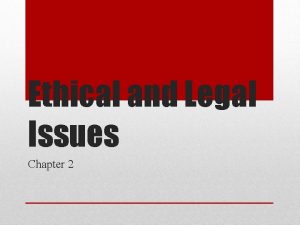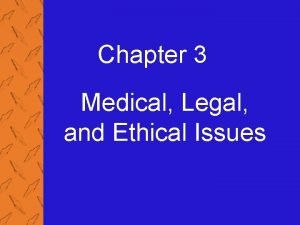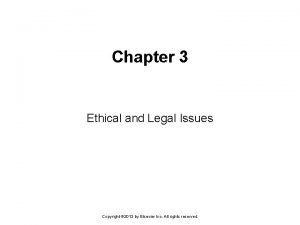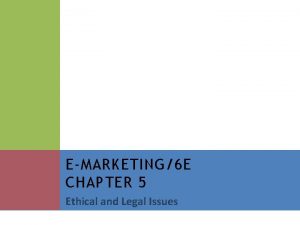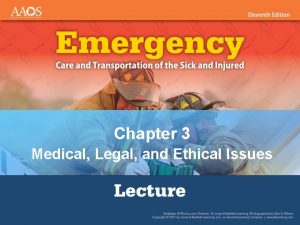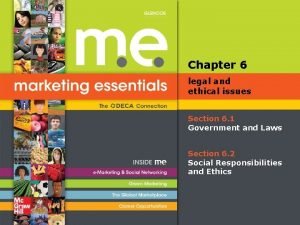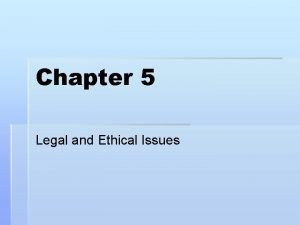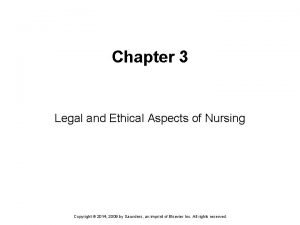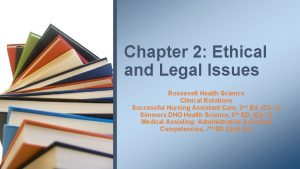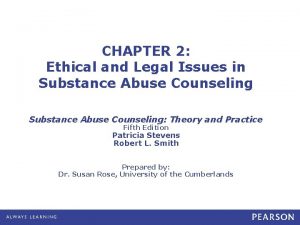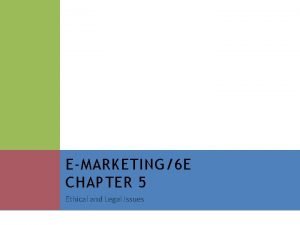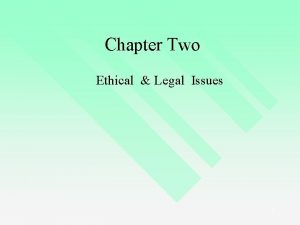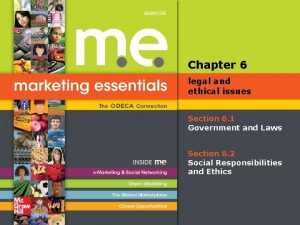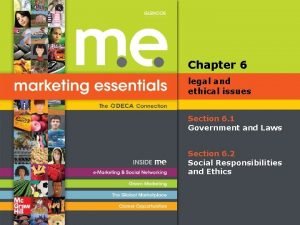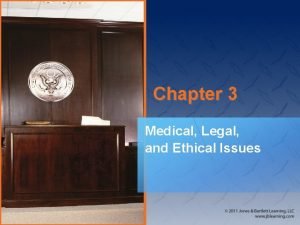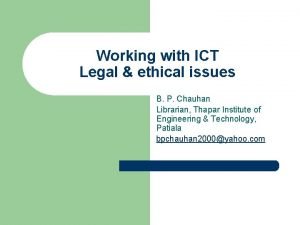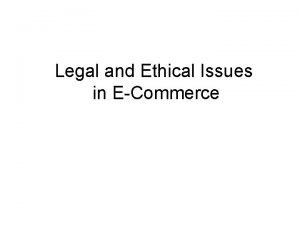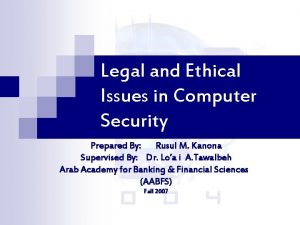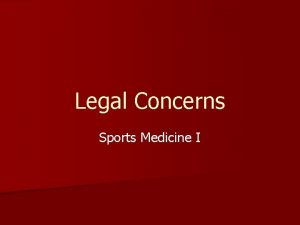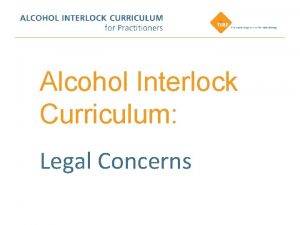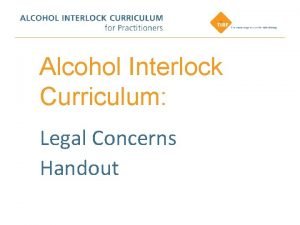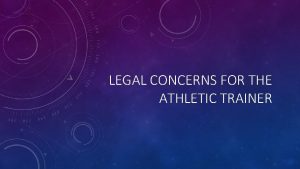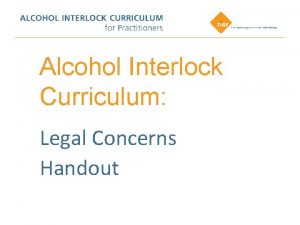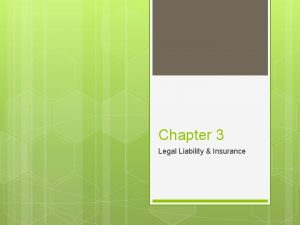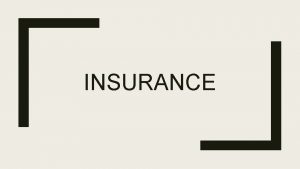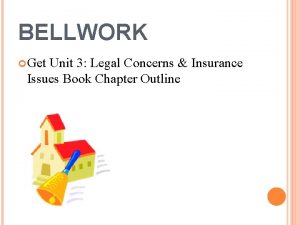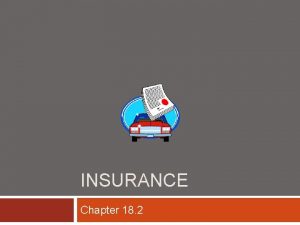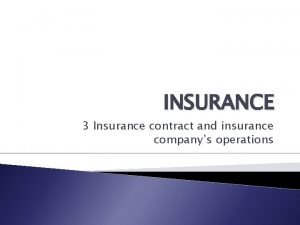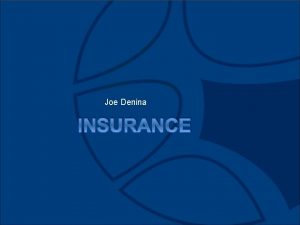CHAPTER 3 LEGAL CONCERNS AND INSURANCE ISSUES LEGAL






















- Slides: 22

CHAPTER 3 LEGAL CONCERNS AND INSURANCE ISSUES

LEGAL CONCERNS OF THE COACH AND ATHLETIC TRAINER • In recent years negligence suits against teachers, coaches, athletic trainers, school officials and physicians are rising from increased sports injuries. • Negligence: the failure to use ordinary or reasonable care • Liability: the state of being legally responsible for the harm one causes another person

Negligence • To establish negligence, an individual making the complaint must establish three things: • 1. Duty of care: existed between the person injured and the person responsible for that injury • 2. Conduct of the defendant fell short of that duty of care • 3. Resultant damage

TORTS • Torts: are legal wrongs committed against the person or property of another. . • A tort also serves as a deterrent by sending a message to the community as to what is unacceptable conduct. • Types of torts: -nonfeasance: an act of omission. . When and individual fails perform a legal duty.

TORTS • Malfeasance (act of commission): when an individual commits an act that is not legally his to perform • Misfeasance: When an individual improperly does something they have the legal right to do.

NEGLIGENCE • Negligence is alleged when an individual: • 1. does something that a reasonably prudent person would not do • 2. Fails to do something that a reasonably prudent person would do under circumstances similar to those shown by the evidence. • To be successful in a suit for negligence an athlete must prove that the athletic trainer’s action or actions made the condition worse.

NEGLIGENCE • Athletic Trainers employed by state-funded school, colleges and universities may be protected by the legal doctrine of Sovereign immunity. • Sovereign immunity: neither the government nor any individual who is employed by the government can be held liable for negligence.

SOVEREIGN IMMUNITY • Sovereign immunity coverage may differ from state to state. • ATC should know the level of coverage their state will provide them. • In the clinical setting, ATC’s have a choice who they treat. Once the ATC assumes the duty of caring for an athlete, the ATC’s has an obligation to make sure the appropriate care is given.

GOOD SAMARITAN LAW • Caregiver for an injured person is expected to provide reasonable care consistent with their level of training. • Good Samaritan law provides limited protection against legal liability to any individual who voluntarily chooses to provide first aid, should something go wrong. .

STATUES OF LIMITATION • Sets a specific length of time that individuals may sue for damages from negligence. • Length of time varies from state to state, but usually somewhere between 1 -3 years. There are exceptions. • Assumption of Risk: the individual through express or implied agreement, assumes that some risk or danger will be involved in the particular undertaking…ie. . Person takes his or her own chances.

REDUCING THE RISK OF LITIGATION FOR THE COACH • 1. Warn athletes of the potential dangers inherent in their sport. • 2. Supervise regularly and attentively • 3. Properly prepare and condition athletes • 4. Properly instruct athletes in the skills of their sports. • 5. Ensure that proper and safe equipment and facilities are used by athletes at all times

REDUCING LITIGATION FOR THE ATC • 1. Work to establish good personal relationships with athletes, coaches, parents and coworkers • 2. Establish specific guidelines and policies for operations of the TR • 3. Develop and carefully follow an emergency plan • 4. Know health status and medical history for all athletes • 5. Keep accurate records on the facility and athletes

Reducing litigation for the ATC • There are many other ways to reduce litigation, but one main rule to follow. . Don’t exceed your knowledge.

INSURANCE CONSIDERATIONS • Over the past 40 years insurance industry has undergone a significant evolutionary process. • Managed care: costs of a health care provider’s medical care closely monitored and scrutinized by insurance carriers. -often preapproval is required prior to care

INSURANCE • As lawsuits increased, the cost of insurance increased. • Increased sports participation also increased the need for insurance, increasing costs. • Different types of insurance: General health insurance, accident insurance, professional liability insurance, and catastrophic insurance.

TYPES OF INSURANCE • General Insurance: covers illness, hospitalization, and emergency care. - Most institutions offer secondary insurance coverage, which pays for an athlete’s remaining medical bills. * Accidental Insurance: low-cost insurance available to the student. Covers accidents on school grounds while the student is in attendance.

TYPES OF INSURANCE • Professional Liability Insurance: protects against damages that may arise from injuries occurring on school property. - covers claims of negligence on the part of individuals. * Catastrophic Insurance: Covers catastrophic injuries to an athlete. Covers medical expenses when they reach $25, 000

THIRD PARTY REIMBURSEMENT • Primary mechanism of payment for medical services in the US. • Policyholder’s insurance company reimburses health care professionals for services performed. • Examples of 3 rd party reimbursement: HMO’s (Health Maintenance Organizations), Preferred Provider Organization (PPO), Point of Service Plan, Exclusive Provider Organization, Physician Hospital Organization, 3 rd Party Administrators, Medicare, Medicaid, Workers Compensation, Indemnity Plans, and Capitation.

TYPES CONTINUED • HMO: provide preventive measures and limit where the individual can receive care. • PPO: provide a discount health but also limit where a person can go for treatment of an illness. • Points of service: (POS): combination of HMO and PPO plans. Allows the members to go outside the HMO to obtain services

TYPES OF INSURANCE • Exclusive Provider Organizations: (EPOs) are also a combo of the HMO and PPO plans. Most will not pay anything if you use out of network providers. • Physician Hospital Organizations: (PHOs) involve a major hospital or chain and its physicians. Contracts directly the employers to provide services.

Types of insurance continued • Third Party Administrators: (TPAs) perform member services such as enrollment and billing and assist with controlling utilization without the financial risk • Medicare: federal health insurance program for the aged and disabled • Medicaid: federal health insurance program for the low income and limited resources.

INSURANCE BILLING • ATC’s must file insurance claims immediately and correctly. • ATC’s in the educational setting are the facilitators in this process. • Usually the insurance company is the Secondary insurance and will pay what they decide is necessary and fair.
 Ethical and legal issues chapter 2
Ethical and legal issues chapter 2 Chapter 3 medical legal and ethical issues
Chapter 3 medical legal and ethical issues Chapter 3 legal and ethical issues
Chapter 3 legal and ethical issues Legal and ethical issues chapter 5
Legal and ethical issues chapter 5 Emt chapter 3 medical legal and ethical issues
Emt chapter 3 medical legal and ethical issues Chapter 6 legal and ethical issues
Chapter 6 legal and ethical issues Legal and ethical issues chapter 5
Legal and ethical issues chapter 5 Legal and ethical aspects of nursing
Legal and ethical aspects of nursing Chapter 2 ethical and legal issues
Chapter 2 ethical and legal issues Chapter 2 ethical and legal issues
Chapter 2 ethical and legal issues Ch 5 legal and ethical responsibilities
Ch 5 legal and ethical responsibilities Legal and ethical issues chapter 5
Legal and ethical issues chapter 5 Chapter 2 ethical and legal issues
Chapter 2 ethical and legal issues Chapter 6 legal and ethical issues
Chapter 6 legal and ethical issues Chapter 6 legal and ethical issues
Chapter 6 legal and ethical issues Medical legal and ethical issues chapter 3
Medical legal and ethical issues chapter 3 Legal ethical and societal issues
Legal ethical and societal issues Professional issues in cyber security
Professional issues in cyber security Elements of fire insurance contract
Elements of fire insurance contract Contemporary issues in marine insurance
Contemporary issues in marine insurance Legal issues of ict in education
Legal issues of ict in education Legal and ethical issues of e commerce
Legal and ethical issues of e commerce Legal and ethical issues in computer security
Legal and ethical issues in computer security
